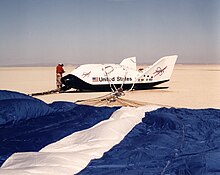Crew Return Vehicle
A Crew Return Vehicle ( CRV ) also known as Crew Rescue Vehicle is a spacecraft that is used to bring space travelers safely back to earth in the event of a serious incident. It has the function of a life capsule or a lifeboat . The term originated with NASA's X-38 project for the International Space Station (ISS) in the mid-1990s and subsequently became a general term for corresponding spacecraft. On the ISS, two Soyuz spaceships serve as CRVs, which can evacuate the crew of six at any time.
The space organizations involved in the construction of the ISS have carried out a large number of studies on the realization of spaceships:
- NASA X-38
- The X-38 was the primary rescue vehicle for the astronauts in the original planning of the station. That is why the term “crew return vehicle” often also refers to this particular spacecraft. It should offer space for seven people. In 2002 the project was discontinued for financial reasons after the construction and flight test of prototypes.
- NASA HL-20
- HL-20 was a predecessor project of the X38 at NASA for a small shuttle for passenger transport.
- Soyuz
- The Russian Soyuz spaceships are currently not only serving as feeder vehicles, but also as emergency vehicles.
- Orion
- As of 2014, the American Orion spaceship was to be used in addition to Soyuz to transport crew to the ISS and back to Earth.
Orion would also have served as an emergency vehicle on these missions. In February 2010, the Constellation program, which also included the Orion spaceship, was discontinued, primarily because of the damning report by the Augustine Commission and the fact that the schedule was delayed for several years. The new manned US spacecraft MPCV, which is based on the developments of the Orion spacecraft, is only expected to be ready for use at the end of the ISS service life (~ 2020) and will therefore probably no longer play a role in crew transport to and from the ISS, and thus also do not serve as a CRV.
- Automated Transfer Vehicle
- As part of the “ATV Evolution” study, which deals with possible further possible uses of the ATV, ESA considered the possibility of developing a CRV based on the ATV for the ISS.
- Kliper
- The planned space shuttle "Kliper" of the Russian space agency could also have been used as a CRV. However, the project was discontinued in 2007.
- COTS program
The manned spacecraft Dragon 2 and CST-100, which have been privately under development since 2006 as part of NASA's COTS program, could also function as CRVs.
